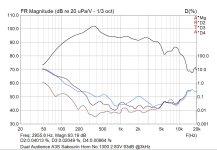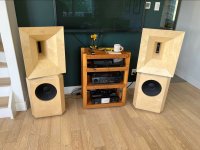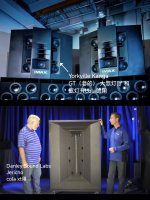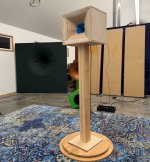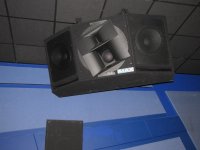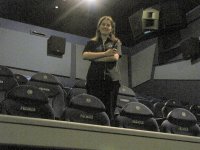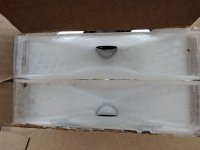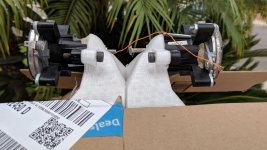The key points I see here are the at the horn area expansion is correct through the combiner, The bends of the combiner are minimised, the outer wall angle joins the main horn smoothly and from a point of simlar width to the throat. The inner wall angle is not straight. I designed the below combiner, it differs on many of these features and it dosen't perform as well:
A key parameter if you design these structures is how close you can pack the compresion drivers (much easier if they are smaller).
I guess bms coaxial and 12" is not possible without having a hole around 600hz, also would not be possible with even 10" because probably paraline almost long as 10" would not work so good.
What do you people think of a 4way synergy.
Dcx464 on a paraline, 2x 5" m5n8-80 (xo 900hz) on sides followed by 2x 12" 12fh520 (500hz).
I think those would be hard to put in 1/4wavelenght but may be possible.
And one question Does speakers driven lets say under 900hz and placed in 1/4 wavelenght couple 6db in all frequency or just some parts?
What do you people think of a 4way synergy.
Dcx464 on a paraline, 2x 5" m5n8-80 (xo 900hz) on sides followed by 2x 12" 12fh520 (500hz).
I think those would be hard to put in 1/4wavelenght but may be possible.
And one question Does speakers driven lets say under 900hz and placed in 1/4 wavelenght couple 6db in all frequency or just some parts?
Tagging on some things that @kipman725 wrote -
Joseph Crowe has an interesting article about using a pair of high quality full ranges loaded on a horn:
https://josephcrowe.com/blogs/news/dual-audience-a3s-fullrange-drivers-in-sabourin-horn-no-1303
Years and years ago, I built something similar using the Aurasound 2" drivers. It worked shockingly well. I actually shelved it because I thought I might be doing something incorrectly. As @Genuine noted, it was one of those projects where you're scratching your head trying to figure out why more companies don't do it.
Having built a lot of horns and waveguides, my guess is that these aren't common in prosound because their output levels are relatively limited. Also, prosound companies tend to offer "metoo" solutions, where you can get very similar speakers from half a dozen different companies. I think this is "a sales thing", basically the sales folks at these companies can't easily move a lot of speakers if they're really far out in leftfield.
These types of horn loaded full ranges solve a lot of problems, but they'll likely need a super tweeter to get them to play to 20khz. But the ability to generate 93dB from a pair of 75mm drivers is quite amazing.
Joseph Crowe has an interesting article about using a pair of high quality full ranges loaded on a horn:
https://josephcrowe.com/blogs/news/dual-audience-a3s-fullrange-drivers-in-sabourin-horn-no-1303
Years and years ago, I built something similar using the Aurasound 2" drivers. It worked shockingly well. I actually shelved it because I thought I might be doing something incorrectly. As @Genuine noted, it was one of those projects where you're scratching your head trying to figure out why more companies don't do it.
Having built a lot of horns and waveguides, my guess is that these aren't common in prosound because their output levels are relatively limited. Also, prosound companies tend to offer "metoo" solutions, where you can get very similar speakers from half a dozen different companies. I think this is "a sales thing", basically the sales folks at these companies can't easily move a lot of speakers if they're really far out in leftfield.
These types of horn loaded full ranges solve a lot of problems, but they'll likely need a super tweeter to get them to play to 20khz. But the ability to generate 93dB from a pair of 75mm drivers is quite amazing.
Attachments
Hi JLH,I decided to simulate the effect the passageway's acoustical size has on the wave propagation inside a paraline. I used Horn Response's wave front simulator. I modeled with two different frequencies (1KHz and 10KHz) and with, and without reflectors.
First picture is the paraline with reflectors. I removed the reflectors for the other set of simulations.
An externally hosted image should be here but it was not working when we last tested it.
The next pic is of a 1KHz frequency being played in the paraline with reflectors. As you'll notice the wave front flows around the bend without issue. It does this because the bend's acoustical dimensions are too small to have an effect.
An externally hosted image should be here but it was not working when we last tested it.
The next pic is the paraline without reflectors. Once again, due to the wave front being acoustically large, the bends are still invisible to it and have no impact.
An externally hosted image should be here but it was not working when we last tested it.
Now we bump up the frequency to 10KHz. We now start to see what happens when our wavelengths become short enough to "see" the acoustic image of the bends.
This next pic is the paraline with reflectors and a 10KHz signal being played. Look at how messed up the waves are. The size of this paraline is too large to support 10KHz. There is a lot of wave front discontinuity going on. However, we still get waves coming out of the mouth slot.
An externally hosted image should be here but it was not working when we last tested it.
Lastly, we have a paraline without reflectors playing a 10KHz signal. There is a lot of discontinuity just like the one with reflectors, however there is almost no output at the mouth slot. There is so much cancellation going on there is almost no waves making out the mouth slot.
An externally hosted image should be here but it was not working when we last tested it.
So, what does this tell us?
1.) If the passageways are sized to the correct dimensions for the highest frequency of interest, then there will not be problems with the bends.
2.) If you over size the passageway, you will get cancellations even with reflectors.
3.) At higher frequencies, having reflectors is better than not having them. I believe this is why you see Danley's paraline with reflectors.
I was reading through your comments, and unfortunately, the images aren't available anymore. Is it possible to share them again? Thanks
GQZ
Do you actually hear up that high? And secondly have you done an analysis of the music you listen to? My hearing poops just below 15k and I have regularly for 20 years watched a musical spectrum analyzer on Foobar as I listen, almost nothing above 14kiliohertz. The odd time on full orchestral. What you show here is a great idea. Leveraging the best that can be had from the system. Joseph is doing some more and more interesting work.Tagging on some things that @kipman725 wrote -
Joseph Crowe has an interesting article about using a pair of high quality full ranges loaded on a horn:
https://josephcrowe.com/blogs/news/dual-audience-a3s-fullrange-drivers-in-sabourin-horn-no-1303
Years and years ago, I built something similar using the Aurasound 2" drivers. It worked shockingly well. I actually shelved it because I thought I might be doing something incorrectly. As @Genuine noted, it was one of those projects where you're scratching your head trying to figure out why more companies don't do it.
Having built a lot of horns and waveguides, my guess is that these aren't common in prosound because their output levels are relatively limited. Also, prosound companies tend to offer "metoo" solutions, where you can get very similar speakers from half a dozen different companies. I think this is "a sales thing", basically the sales folks at these companies can't easily move a lot of speakers if they're really far out in leftfield.
These types of horn loaded full ranges solve a lot of problems, but they'll likely need a super tweeter to get them to play to 20khz. But the ability to generate 93dB from a pair of 75mm drivers is quite amazing.
Hello everybody!
First of all, thanks for all the sharing of the experiences!
I started my Paraline journey a while back and I wanted to share the results of my last version! I use a DCX464 and I used a eq to make it flat. (didn't eq that much)
It's not that easy to reengineer the paraline design! it took a lot of time! But I really like my last design. (3d printed out of PLA)
Does some have experience with "baffle diffraction" off the front of the paraline?
Height lens 26cm layers 6mm opening 20mm
first measurements close to the paraline
second on the floor outside. (not ideal)


First of all, thanks for all the sharing of the experiences!
I started my Paraline journey a while back and I wanted to share the results of my last version! I use a DCX464 and I used a eq to make it flat. (didn't eq that much)
It's not that easy to reengineer the paraline design! it took a lot of time! But I really like my last design. (3d printed out of PLA)
Does some have experience with "baffle diffraction" off the front of the paraline?
Height lens 26cm layers 6mm opening 20mm
first measurements close to the paraline
second on the floor outside. (not ideal)


I hope this is working 🙂
The 10k dropoff of the full range measurement is because of the not so great measuring conditions.


The 10k dropoff of the full range measurement is because of the not so great measuring conditions.
It is indicative of real world conditions. And the happy fact is there is little useable high frequency in music above 13k anyway. Well done in room frequency response.The 10k dropoff of the full range measurement is because of the not so great measuring conditions.
yes that's true's, and the differences is also in the mics.
I didn't mentioned dat the full range measurement was taken with a dbx mic and the paraline alone with a umik-1. They measure quite different above 4khz.
I ordered a Isemcon emx 7150, so I can measure with the same mic.
I didn't mentioned dat the full range measurement was taken with a dbx mic and the paraline alone with a umik-1. They measure quite different above 4khz.
I ordered a Isemcon emx 7150, so I can measure with the same mic.
Pics please?
Would love to see how you built it.
Would love to see how you built it.
Todd Michael made an offhand comment that there's Paralines in IMAX theatres, and I never noticed the first time he posted it here:
So I found some pics (see attached.)
While it's not as "pretty" as the giant Synergy Horns that William Cowan made for A for Ara (see attached), it's cool that you can probably listen to a HUGE Unity (Synergy?) Horn in nearly any state, if you're near an Imax.
If you look at the way the GIGANTIC ones are set up, it looks like they're designed to be coaxial all the way down to 150Hz or so. (Note the low frequency drivers BEHIND the horn that sits in front of them. That makes it coaxial, similar to the giant "A for Ara" speaker, just not as pretty.)
Some have said that there are Danley Jericho speakers in some Imax theatres, but I think the third pic is actually a Yorkville speaker. Note that the ports are located where Yorkville puts their ports on their prosound Paraline speakers. And the horn appears to be shaded.
So I found some pics (see attached.)
While it's not as "pretty" as the giant Synergy Horns that William Cowan made for A for Ara (see attached), it's cool that you can probably listen to a HUGE Unity (Synergy?) Horn in nearly any state, if you're near an Imax.
If you look at the way the GIGANTIC ones are set up, it looks like they're designed to be coaxial all the way down to 150Hz or so. (Note the low frequency drivers BEHIND the horn that sits in front of them. That makes it coaxial, similar to the giant "A for Ara" speaker, just not as pretty.)
Some have said that there are Danley Jericho speakers in some Imax theatres, but I think the third pic is actually a Yorkville speaker. Note that the ports are located where Yorkville puts their ports on their prosound Paraline speakers. And the horn appears to be shaded.
Attachments
Side note: The Imax subs appear to be Eminence Lab12. Makes sense, since Danley spec'd the design for the original labsub from about 25 years ago, and the driver has been used in numerous Danley speakers (and apparently Yorkville speakers too.)
Check out the cones from the "Yorkville Kanga" pictured above, and compare to this pic.
Also, if you're international, there was some discussion on Reddit that indicates this setup is present in Chinese Imax theatres. If it's there, safe to assume it's in other countries also.
Check out the cones from the "Yorkville Kanga" pictured above, and compare to this pic.
Also, if you're international, there was some discussion on Reddit that indicates this setup is present in Chinese Imax theatres. If it's there, safe to assume it's in other countries also.
Attachments
Although the Danley DSL-12 looks very similar to the LAB12, there are differences.Side note: The Imax subs appear to be Eminence Lab12. Makes sense, since Danley spec'd the design for the original labsub from about 25 years ago, and the driver has been used in numerous Danley speakers (and apparently Yorkville speakers too.)
Check out the cones from the "Yorkville Kanga" pictured above, and compare to this pic.
Note the single small vent on the rear of the LAB12, it's smaller voice coil heats up rapidly compared to the DSL-12 on the right with the additional 8 vents:
The larger diameter and depth of the DSL-12 voice coil and the additional cooling vents provide 2mm more excursion, more power handling and better heat dissipation.
Other differences can be noted in the TS parameters (courtesy of DataBass):
Both drivers are made by Eminence, but the DSL-12 is sold by Danley Sound Labs.
Art
This isn't a Paraline, but my thread on Sausaliton Audio Works lenses was closed, so I guess I'll put this here.
Attached are a couple of pics of my attempt to combine two compression drivers using a SAW lens.
Same idea as this, but sandwiched together:

It didn't work great at high frequencies. It actually worked fairly well below 10khz. Some fins and a proper waveguide (not cardboard) would go a long way.
Attached are a couple of pics of my attempt to combine two compression drivers using a SAW lens.
Same idea as this, but sandwiched together:

It didn't work great at high frequencies. It actually worked fairly well below 10khz. Some fins and a proper waveguide (not cardboard) would go a long way.
Attachments
Those 3 pictures are of old IMAX products that do not use Paraline/Synergy technologies and were replaced by the new products I designed. The "Yorkville" picture is one of those new IMAX products that does use those technologies and the horn is not "shaded".Todd Michael made an offhand comment that there's Paralines in IMAX theatres, and I never noticed the first time he posted it here:
So I found some pics (see attached.)
While it's not as "pretty" as the giant Synergy Horns that William Cowan made for A for Ara (see attached), it's cool that you can probably listen to a HUGE Unity (Synergy?) Horn in nearly any state, if you're near an Imax.
If you look at the way the GIGANTIC ones are set up, it looks like they're designed to be coaxial all the way down to 150Hz or so. (Note the low frequency drivers BEHIND the horn that sits in front of them. That makes it coaxial, similar to the giant "A for Ara" speaker, just not as pretty.)
Some have said that there are Danley Jericho speakers in some Imax theatres, but I think the third pic is actually a Yorkville speaker. Note that the ports are located where Yorkville puts their ports on their prosound Paraline speakers. And the horn appears to be shaded.
Again... the old IMAX sub woofer designed by them used 4xLAB12's and was a reliability nightmare. I designed a new Tapped Horn sub woofer for them which one cabinets replaces two of the old ones and there has not been a single woofer failure in over 7 years. We've never used the LAB 12 in any Yorkville products.Although the Danley DSL-12 looks very similar to the LAB12, there are differences.
Note the single small vent on the rear of the LAB12, it's smaller voice coil heats up rapidly compared to the DSL-12 on the right with the additional 8 vents:
View attachment 1461320
The larger diameter and depth of the DSL-12 voice coil and the additional cooling vents provide 2mm more excursion, more power handling and better heat dissipation.
Other differences can be noted in the TS parameters (courtesy of DataBass):
View attachment 1461321
Both drivers are made by Eminence, but the DSL-12 is sold by Danley Sound Labs.
Art
I had a client come to me with the original version of this horn. Epic EQ was required to get a reasonable response from the original data. I still have the STL files for it come to think about it. It was so much a band aid type of job that I refused to work on it. Normally an as measured response doesn't need too much EQ when the horn is properly designed. Perhaps your new version mitigates this.This isn't a Paraline, but my thread on Sausaliton Audio Works lenses was closed, so I guess I'll put this here.
Attached are a couple of pics of my attempt to combine two compression drivers using a SAW lens.
Same idea as this, but sandwiched together:

It didn't work great at high frequencies. It actually worked fairly well below 10khz. Some fins and a proper waveguide (not cardboard) would go a long way.
- Home
- Loudspeakers
- Multi-Way
- Square Pegs
